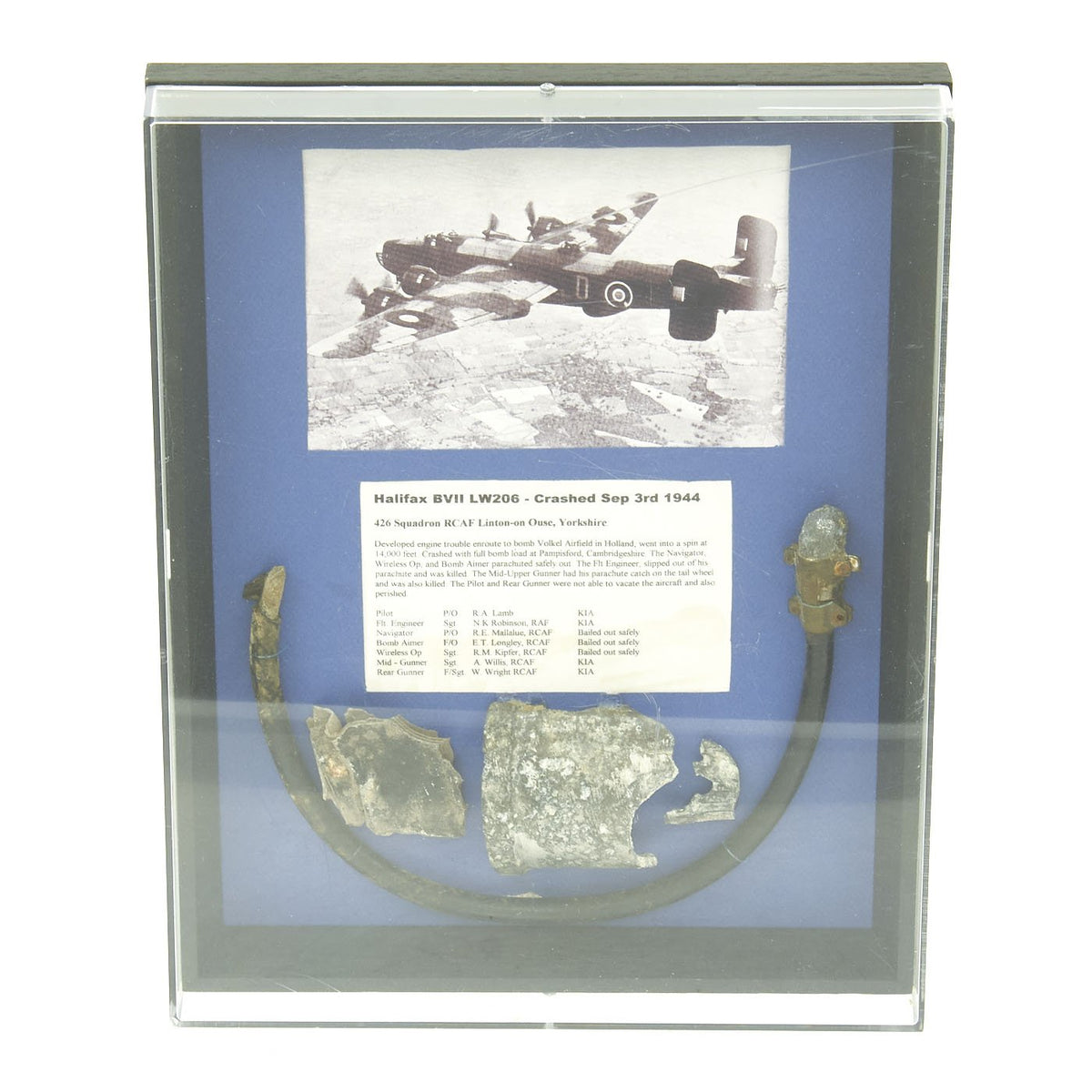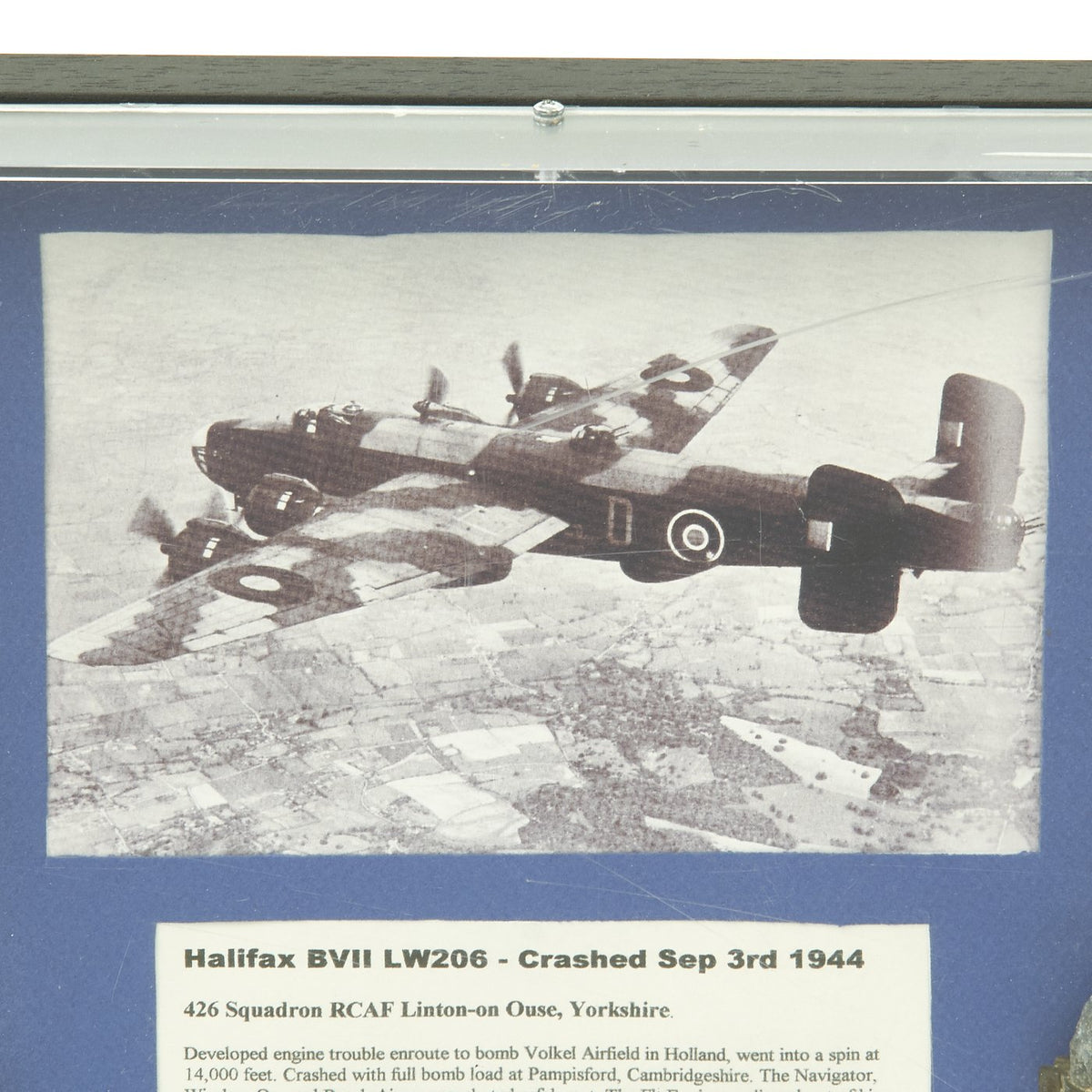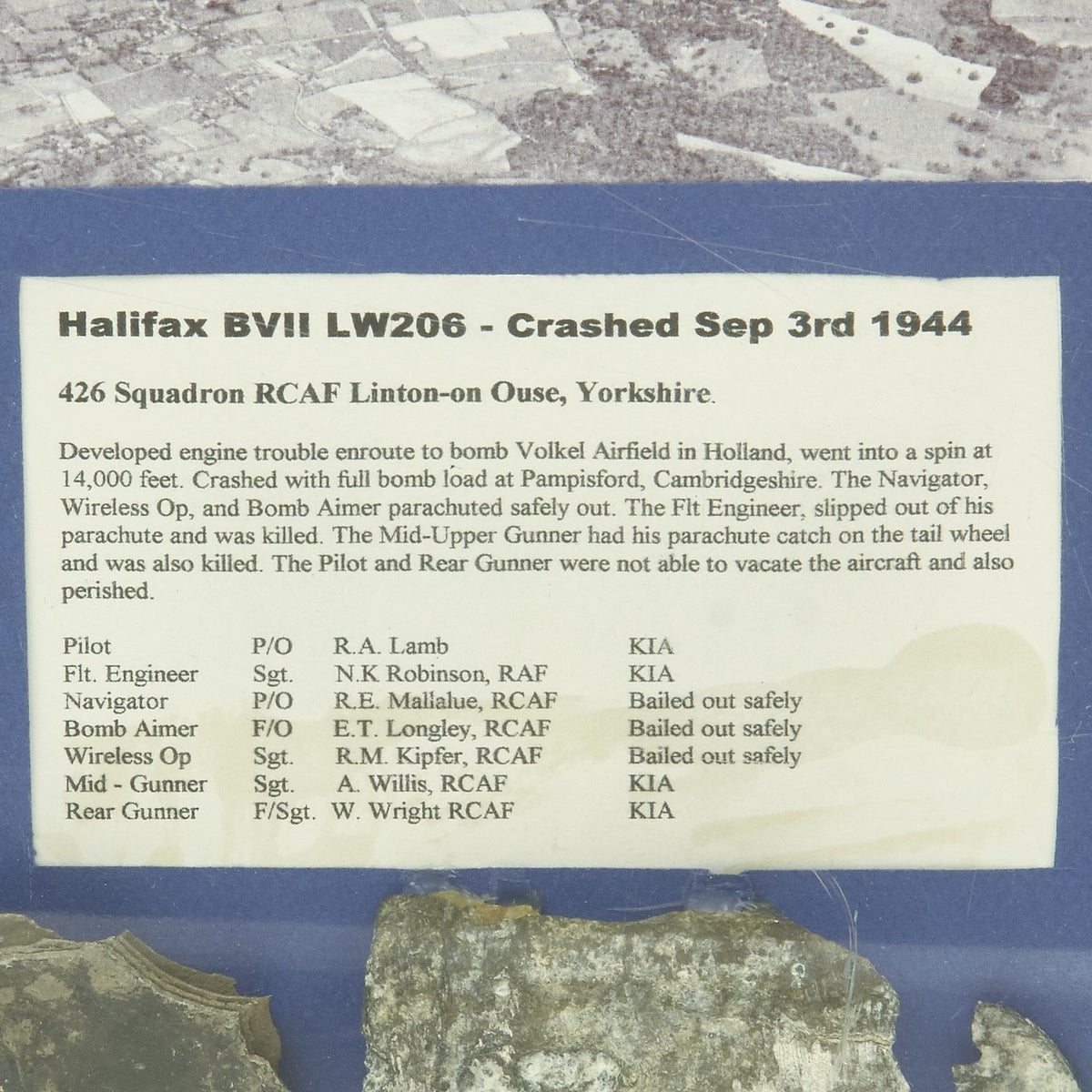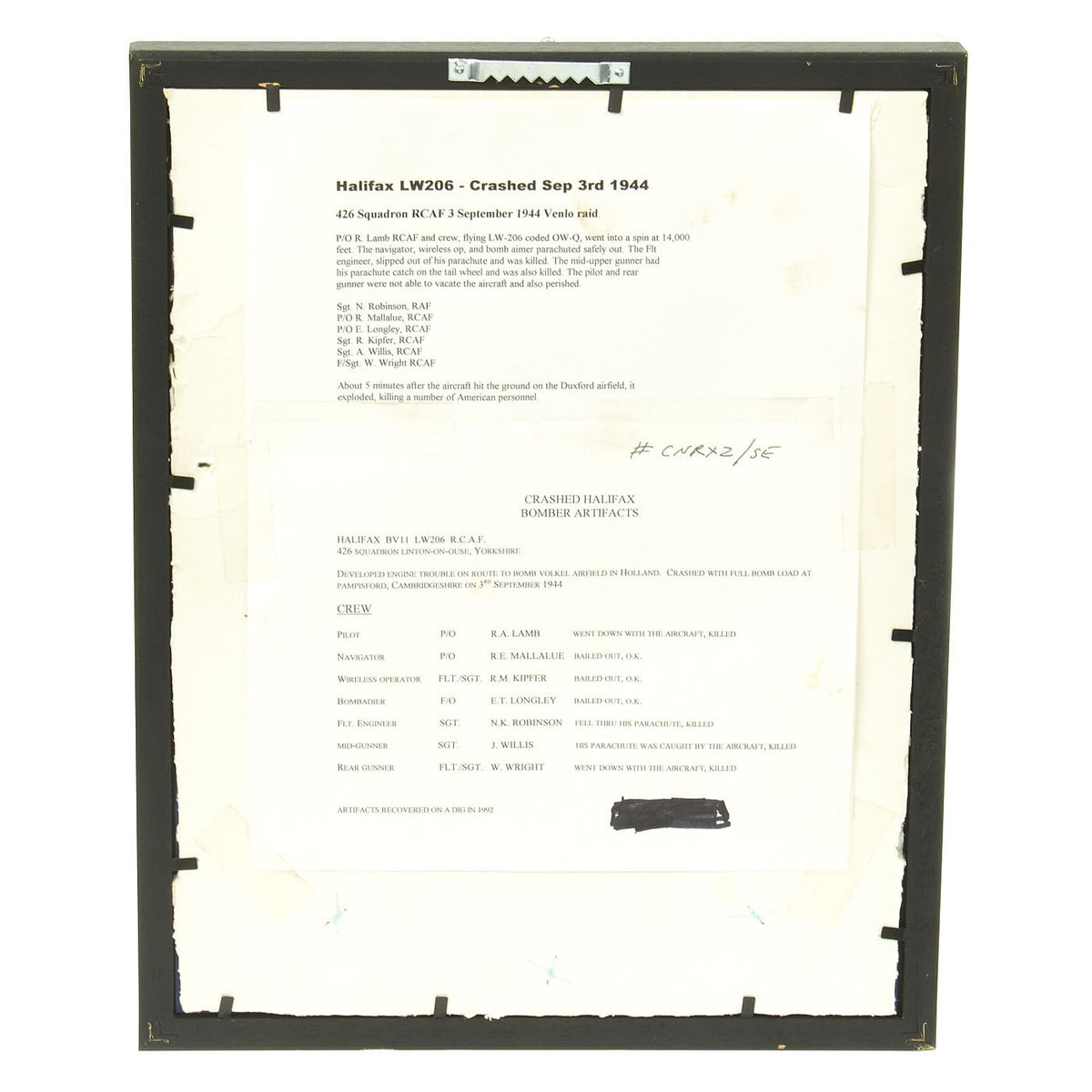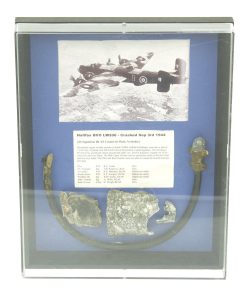Original British WWII Fragments from R.C.A.F. H.P.63 Halifax B.VII Bomber LW206 – Crashed 3 Sept. 1944 Original Items
$ 250,00 $ 100,00
Original Items: One-of-a-kind set. Here we have a very nice cased set of aircraft fragments, from Royal Canadian Air Force Halifax B.VII Serial number LW206. It unfortunately crashed shortly after takeoff in England, resulting in the deaths of four crew members, while three survived.
During WWII, air technology was unfortunately nowhere near as reliable as it is today. It had only been around 40 years since the Wright Brother’s first flight, and engine technology was not nearly as streamlined as today. Developing engine trouble was unfortunately not uncommon, and as in this case, can result in the loss of the entire plane if the situation is not quickly dealt with.
At the top inside this case is a picture of a Handley Page Halifax H.P.63 B.VII Bomber, though we do not believe it is the specific bomber that these crash fragments came from. Below this is the basic story regarding the crash:
Halifax BVII LW206 – Crashed Sep 3rd 1944
426 Squadron RCAF Linton-on Ouse, Yorkshire
Developed engine trouble enroute to bomb Volkel Airfield in Holland, went into a spin at 14,000 feet. Crashed with full bomb load at Pampisford, Cambridgeshire. The Navigator, Wireless Op, and Bomb Aimer parachuted safely out. The Flt Engineer, slipped out of his parachute and was killed. The Mid-Upper Gunner had his parachute catch on the tail wheel and was also killed. The Pilot and Rear Gunner were not able to vacate the aircraft and also perished.
Below this are the names of the 7 crew members, indicating their role, rank, and fate. They were mostly from the Royal Canadian Air Force, but some were from the British Royal Air Forces.
Underneath this are fragments recovered from the crash site, most of which are aluminum, though there is also what looks to be a cable of some sort. They are attached to the fabric backing inside. The case itself measures 14 3/8″H x 11 3/8″W x 2″, and has a clear plastic cover. The frame looks to be wood, though it could be composite or metal. The plastic cover does have some cracks and scratches. On the back of the case are some printed pages with more information.
A somewhat somber set of crash relics from an Allied bomber in WWII that never made it to the target. Ready to display.
The Handley Page Halifax is a British Royal Air Force (RAF) four-engined heavy bomber of the Second World War. It was developed by Handley Page to the same specification as the contemporary twin-engine Avro Manchester.
The Halifax has its origins in the twin-engine HP56 proposal of the late 1930s, produced in response to the British Air Ministry’s Specification P.13/36 for a capable medium bomber for “world-wide use.” The HP56 was ordered as a backup to the Avro 679, both aircraft being designed to use the underperforming Rolls-Royce Vulture engine. The Handley Page design was altered at the Ministry to a four-engine arrangement powered by the Rolls-Royce Merlin engine; the rival Avro 679 was produced as the twin-engine Avro Manchester which, while regarded as unsuccessful mainly due to the Vulture engine, was a direct predecessor of the famed Avro Lancaster. Both the Lancaster and the Halifax would emerge as capable four-engined strategic bombers, thousands of which would be built and operated by the RAF and several other services during the War.
On 25 October 1939, the Halifax performed its maiden flight, and it entered service with the RAF on 13 November 1940. It quickly became a major component of Bomber Command, performing routine strategic bombing missions against the Axis Powers, many of them at night. Arthur Harris, the Air Officer Commanding-in-Chief of Bomber Command, described the Halifax as inferior to the rival Lancaster, in part due to its inability to carry larger individual bombs such as the 4,000 pound “Cookie” blast bomb. Nevertheless, production of the Halifax continued until April 1945. During their service with Bomber Command, Halifaxes flew a total of 82,773 operations and dropped 224,207 tons of bombs, while 1,833 aircraft were lost. The Halifax was also flown in large numbers by other Allied and Commonwealth nations, such as the Royal Canadian Air Force (RCAF), Royal Australian Air Force (RAAF), Free French Air Force and Polish forces.
Various improved versions of the Halifax were introduced, incorporating more powerful engines, a revised defensive turret layout and increased payload. It remained in service with Bomber Command until the end of the war, performing a variety of duties in addition to bombing. Additionally, specialised versions of the Halifax were developed for troop transport and paradrop operations. Following the end of the Second World War, the RAF quickly phased the Halifax out of service, after the type was succeeded in the strategic bombing role by the Avro Lincoln, an advanced derivative of the Lancaster. During the post-war years, the Halifax was operated by the Royal Egyptian Air Force, the French Air Force and the Royal Pakistan Air Force. The type also entered commercial service for a number of years, used mainly as a freighter. A dedicated civil transport variant, the Handley Page Halton, was also developed and entered airline service. 41 civil Halifax freighters were used during the Berlin Airlift. In 1961, the last remaining Halifax bombers were retired from operational use.
Fast Shipping with Professional Packaging
Thanks to our longstanding association with UPS FedEx DHL, and other major international carriers, we are able to provide a range of shipping options. Our warehouse staff is expertly trained and will wrap your products according to our exact and precise specifications. Prior to shipping, your goods will be thoroughly examined and securely secured. We ship to thousands clients each day across multiple countries. This shows how we're dedicated to be the largest retailer on the internet. Warehouses and distribution centres can be located throughout Europe as well as the USA.
Note: Orders with more than one item will be assigned a processing date depending on the item.
Before shipping before shipping, we'll conduct a thorough inspection of the items you have ordered. Today, the majority of orders will be delivered within 48 hours. The delivery time will be between 3-7 days.
Returns
The stock is dynamic and we cannot completely manage it because multiple stakeholders are involved, including our factory and warehouse. So the actual stock may alter at any time. It's possible that you may not receive your order once the order has been made.
Our policy is valid for a period of 30 days. If you don't receive the product within 30 days, we are not able to issue a refund or an exchange.
You can only return an item if it is unused and in the same state as the day you received it. You must have the item in its original packaging.
Related products
Uncategorized
Uncategorized
Uncategorized
Uncategorized
Armored Burgonet Helmet & Polearm from Scottish Castle Leith Hall Circa 1700 Original Items
Uncategorized
Uncategorized
Uncategorized
Uncategorized
Uncategorized
Uncategorized
Armoured Fighting Vehicles of the World: AFVs of World War One (Hardcover Book) New Made Items
Uncategorized
Uncategorized
Uncategorized
Uncategorized
Angolan Rebel 1970s era 60mm Inert Display Mortar from Angolan Civil War Original Items
Uncategorized
Band of Brothers ORIGINAL GERMAN WWII Le. F.H. 18 10.5cm ARTILLERY PIECE Original Items
